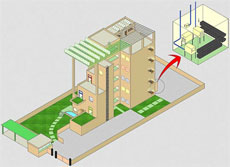Solar energy
.jpg)
The hybrid solar power system in the Centre for Science and Environment acts as an on-line uninterrupted power supply (UPS) system, providing stable power to all the electronic appliances.
120 solar modules are mounted on a space frame over the front twin-pillar supported pergola of the CSE building. The remaining 20 are installed over the CSE canteen roof.
Components
The 10 kilowatt power (kWp) photovoltaic power plant in CSE comprises the following components:
-
Solar modules
-
Power conditioning unit (PCU)
-
Battery bank
Peripheral components
-
Data logging system with personal computer (PC)/printer
-
Direct current (DC) and alternating current (AC) distribution boards
-
Earthing kits and electricity distributing cables

Solar modules
Solar cell or photovoltaic (PV) cell is composed of semiconductor materials – silicon wafers.
Photovoltaic cell, as the word implies (photo = light, voltaic = electricity), converts sunlight directly into electricity.
Several PV cells go into the making of a solar module.
CSE solar PV array comprises 140 solar modules – 10 modules connected in series and 14 in parallel – of 75 watts (W) and 12 volts (V) each.
Power conditioning unit
The 10 kilovolt ampere (kVA) PCU of 120 V DC and 230 V AC acts as
a. an inverter – converting DC to AC – and
b. a solar charge conditioner – controlling current for efficient and optimal battery charging. It is connected to 220 V AC grid supply.
Battery bank
Sixty PV batteries of 120 V, 2-1,200 ampere hour (Ah) are the energy reservoirs.
.jpg)
How CSE benefits
-
The cost of installation of the system (Rs 36.55 lakh) can be recovered in two years, if the gross savings are taken into account.
-
Every month, CSE saves about Rs 8000-10,000 on its electricity bill.
-
Solar power helps in saving approximately Rs 20 lakh per annum if we assume that it takes 35-minutes of rebooting daily and 5-7 power outages a day leading to a loss of Rs. 50 in the output of each employee.
-
CSE never shuts down. Its critical appliances are connected to the 24-hour solar energy back up.
-
Steady power supply prevents damage to computers and loss of precious data. It reduces dependence on the diesel generator.
-
With all its electronic appliances connected to solar energy, CSE has managed to dispense with the UPS and associated recurring costs.
-
In the event of both mains and power backup failing, solar system is capable of supplying six hours of instant and uninterrupted power.

Share this article